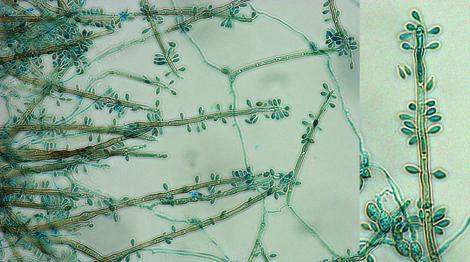Myrmecridium schulzeri
Synonymy:
Ramichloridium schulzeri
Ramichloridium schulzeri was placed in a new genus, Myrmecridium by Arzanlou et al. (2007).
M. schulzeri is an uncommon soil saprophyte of worldwide distribution. It has also been isolated from plant detritus and as a contaminant of bronchoscopy fluid. It is the causative agent of “Golden Tongue” syndrome reported by Rippon et al. (1985).
RG-1 organism.

Myrmecridium schulzeri conidiophores showing sympodial development of conidia.
Morphological description:
Colonies growing moderately rapidly, consisting of a rather compact, flat, submerged mycelium, pale orange, locally with some powdery, brownish aerial mycelium; reverse pink to orange. Conidiophores are erect, straight, unbranched, thick-walled, reddish-brown, up to 250 µm high, gradually becoming paler towards the apex, of variable length, elongating sympodially during conidiogenesis, with scattered, pimple-shaped conidium bearing denticles which have unpigmented scars. Conidia are subhyaline, smooth-walled or slightly rough-walled, ellipsoidal, obovoidal or fusiform, 6.5-10 x 3-4 µm, usually with an acuminate base and unpigmented scars.
Molecular identification:
ITS and D1/D2 sequencing may be used for accurate species identification (Halliday et al. 2015).
Note: Myrmecridium species can be distinguished from other Ramichloridium-like fungi by having entirely hyaline vegetative hyphae, and widely scattered, pimple-shaped denticles on the long hyaline rachis. The conidial sheath is also visible in lactic acid mounts with bright field microscopy Arzanlou et al. (2007).
References:
de Hoog (1977), Rippon et al. (1985), de Hoog et al. (2000, 2015), Arzanlou et al. (2007).
| No | ≤0.016 | 0.03 | 0.06 | 0.125 | 0.25 | 0.5 | 1 | 2 | 4 | ≥8 | |
|---|---|---|---|---|---|---|---|---|---|---|---|
| AmB | 1 | 1 | |||||||||
| VORI | 1 | 1 | |||||||||
| POSA | 1 | 1 | |||||||||
| ITRA | 1 | 1 |
